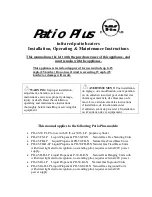
15
Operating Instructions and Owner’s Manual
Enerco | enerRadiant® HST Series Heater
Double Wall
Double wall vent run and
Double wall terminal end
Vertical Venting
a) Three (3") inch O.D. flue pipe, maximum twenty five (25') feet in
length may be used as shown with approved vent cap.
b) An insulated thimble may be required to pass through
combustible structures (check local codes).
c) All flue joints should be sealed using suitable products (see
recommendation for horizontal venting).
a) Be sure that method selected for venting heater complies with
all codes as required for each particular location.
b) Exhaust end of heater will accept a three (3") inch flue pipe
using the flue pipe adapter.
c) Heater may be vented to the outdoors either vertically or
horizontally.
d)
If heater is to be vented horizontally:
1) Vent must exit building not less than seven (7') feet above
grade when located adjacent to public walkways.
2) Vent must terminate at least three (3') feet above any forced
air inlet located within ten feet (10').
3) Vent must terminate at least four (4') feet below, for (4')
feet horizontally from, or one (1') foot above any door,
window, or gravity inlet into any building.
4) Vent terminal shall be located at least twelve (12") inches
from any opening through which vent gases could enter the
building.
e) Vent terminal opening must be beyond any combustible
overhang.
f) If condensation in the flue is a problem, the flue length should
be shortened or insulated.
g) For vent specifications all of the following conditions must be
met:
The maximum equivalent length of vent pipe should be
carefully observed. A safety switch in the heater is designed to
shut the heater off before excessive flue restriction causes bad
combustion.
Minimum Equivalent Length = 5 feet of Pipe
Maximum Equivalent Length = 25 feet of Pipe
Use the following correction factors to obtain the equivalent
length:
1) Subtract 15 feet if the run is horizontal.
2) Subtract 10 feet for an approved vent cap.
3) Subtract 10 feet for each elbow beyond 15 feet from the
heater.
4) Subtract 15 feet for each elbow within 15 feet of the heater.
Limit the quantity of 90º elbows to two. When vent pipe is in a
horizontal run, it must rise not less than 1/4 inch per foot from
the start of the vent system towards the vent terminal.
Alternative Arrangements /Optional
Equipment for Venting
Horizontal Venting
a) In combustible or noncombustible walls, use vent kits on page
(3). Follow vent manufacturer's instructions for proper
installation.
b) Three (3") inch O.D. flue pipe is required. Twenty five (25') feet
maximum length is recommended.
c) All flue joints should be sealed using suitable product such as
General Electric RTV 106 or Permatex Form-A-Gasket Red High
Temperature Silicone Adhesive Sealant.
d) Vent terminal should be installed at a height sufficient to
prevent blockage by snow.
e) Building materials should be protected from degradation by flue
gases.
Single Wall
Single wall vent run
Single wall terminal end










































